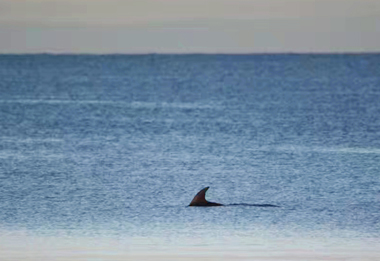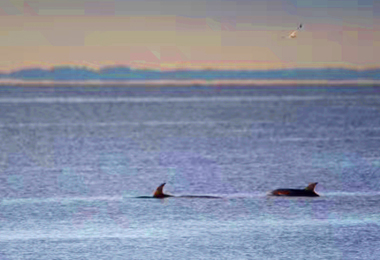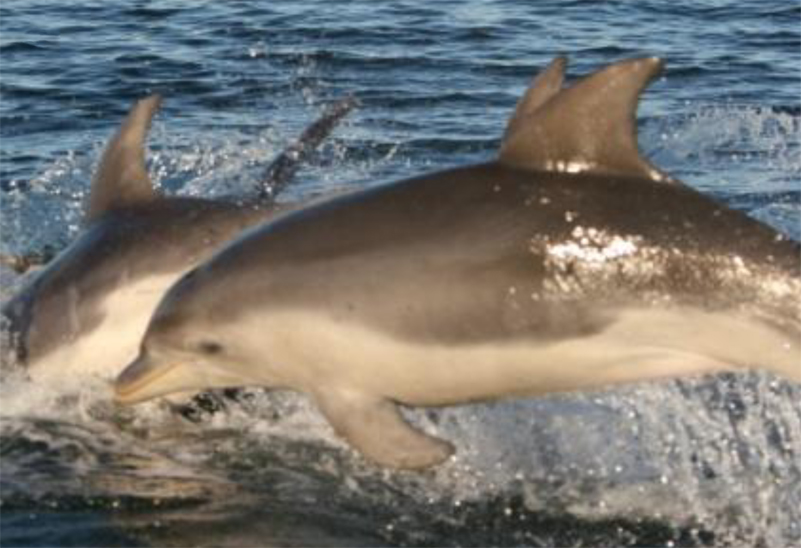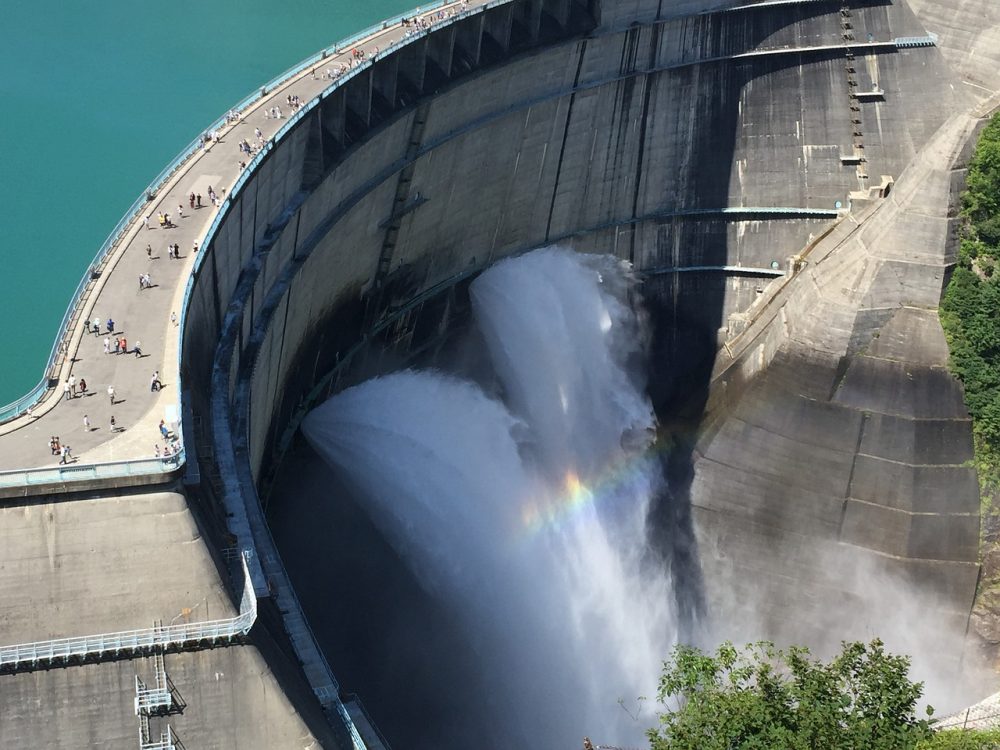Burrunan dolphins in Victoria
The Burrunan dolphin (Tursiops australis) is a rare and endangered species of bottlenose dolphins, with two genetically distinct year-round resident populations in Victoria. There are currently about 120 dolphins in Port Phillip Bay and 65 dolphins in the Gippsland Lakes. Burrunan dolphins have also been sighted at other locations in Victoria, Tasmania and South Australia.

Burrunan dolphins in Port Phillip Bay
In Port Phillip Bay, Burrunan dolphins are seen between Port Phillip Heads, Port Melbourne, St Kilda and Altona. They move south to areas around Sorrento and Portsea in summer and north towards Melbourne city in winter. Burranan dolphins had been spotted in Yarra and Maribyrnong rivers. The two photographs of dolphins shown below were taken last year by Dr. Lawrence Chan of Altona Meadows Family Medical Clinic from the coast of Altona, near Millers Road.


Source: Dr. Lawrence Chan
Bottlenose dolphin species
The Burrunan dolphins were originally thought to be one of two recognised species of bottlenose dolphins, the common bottlenose dolphin (Tursiops truncatus) and the Indo-Pacific bottlenose dolphin (Tursiops aduncus). The misclassification came about because they share characteristics with both the common bottlenose and the Indo-Pacific bottlenose dolphins. They have a curved dorsal fin and a stubby rostrum (nose) similar to the common bottlenose dolphins but were smaller and lighter in colour similar to the Indo-Pacific bottlenose dolphins.

Source: Wikicommons
The Burrunan dolphins is 2 to 2.5 metres long, slightly larger than the Indo-Pacific bottlenose dolphins but smaller than the common bottlenose dolphins which can grow up to 4 metres in length. It has a unique tri-colouration pattern, from dark grey on the upper side of the body, a paler grey midline and cream underside, which reaches over the eye and the flipper in some instances.
New species
Dr. Kate Charlton-Robb is a dolphin expert who has spent more than 10 years researching the Burrunan dolphins. While doing her Ph.D degree with Monash University, she conducted DNA tests which show that the Burrunan dolphins are genetically very different from the other two Bottlenose species. Her team also examined dolphin skulls that were collected and maintained by Museum Victoria and other Australian museums dating back to the early 1900s. These analyses determined that the Burrunan dolphins have slight cranial differences that distinguish them from the other two species.
Dr. Charlton-Robb’s research work led to the classification of the Burrunan dolphins as a unique, separate species in 2011. It is the third time since the late 1800s that a new dolphin species has been recognised.
Naming the Dolphin
Dr. Charlton-Robb named the new species Tursiops australis where australis means “southern” in Latin, and refers to the Australian range of the dolphin.
The common name “Burrunan” means “large sea fish of the porpoise kind” in the Aboriginal Boonwurrung, Woiwurrung and Taungurung languages.
Endangered species
Some dolphin species are in danger of becoming extinct, with the greatest threats coming from human activities. Dolphins are increasingly killed each year from dynamite fishing, entanglement in fishing nets, collisions with boats and propellers, marine pollution, disease, disorientation and beaching due to sonar interference.
The very small population size, lack of genetic diversity, isolation of these populations, proximity to urban areas and human activities make Burrunan dolphins especially vulnerable.
“Given that it is a small population there is concern, ” Dr. Charlton-Robb said. “The higher the genetic diversity, the better the conservation and longevity of the population will be. ”
In 2013, Dr Charlton-Robb founded the Marine Mammal Foundation (MMF), whose research has been crucial in getting the Burrunan dolphin listed as endangered under the Victorian Flora and Fauna Guarantee Act.
MMF is continuing its research and learning more about the Burrunan dolphin so that it can apply for listing of the Burrunan dolphin under the Federal Environment Protection and Biodiversity Conservation (EPBC) Act and the International Union for Conservation of Nature (IUCN) Red List.
There has not been sufficient data to support the IUCN in according the conservations status of the Burrunan dolphin. Hence, research work by MMF plays a critical role in gaining the endangered status for this species, which in turn is needed in securing funds for its protection.
How to help Burrunan dolphins
MMF had suggested you can help Burrunan dolphins in the following ways:
- Keep a distance from dolphins of at least 100m if in a vessel or 300m on a jet ski.
- Practise sustainable recreational fishing.
- Reduce single-use plastic items and littering.
- Become involved in MMF education and outreach programs, as a volunteer or citizen scientist.
- Adopt a Burrunan dolphin.
References
- https://marinemammal.org.au
- https://en.wikipedia.org/wiki/Burrunan_dolphin
- https://www.dolphins-world.com/burrunan-dolphin-tursiops-australis
- https://theconversation.com/small-and-isolated-dolphin-populations-are-under-threat-32507
- https://www.monash.edu/news/articles/2443
- https://news.nationalgeographic.com/news/2011/09/110916-new-dolphin-species-australia-science-plos-melbourne
- https://sussle.org/t/Burrunan_dolphin
- http://www.abc.net.au/local/audio/2014/01/09/3922752.htm
- https://www.smh.com.au/environment/conservation/researcher-says-bay-dolphins-in-a-class-of-their-own-20101216-18zm4.html





Hi I live on the coast at Inverloch and over the last three days have sighted a large pod of dolphins firstly moving from Inverloch and forming a line out to sea hunting and pushing a school of salmon funnelling them back towards the coast. Next morning around 10 am on the incoming tide at a place called Twin reefs they again showed up this time coming from Cape Patterson hugging close to the shore, then starting to fan out again moving closer to Inverloch again most likely chasing the schools of salmon. These dolphins appeared to have the marking of the Burrunan and about the same size and curved dorsal fin as described. Appeared to be 50+ in the pod could have been much more. My question is do you think they could be Burrunan and could they be the pod from either Port Phillip or Lakes out in a hunting trip? Kind regards Dave Doc